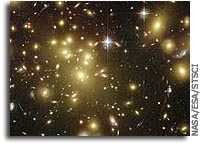Natural Zoom Lens Allows Hubble to See Deep into the Cosmos

The Advanced Camera for Surveys (ACS), aboard NASA’s
Hubble Space Telescope, has used a natural “zoom lens” in
space to boost its view of the distant universe. Besides
offering an unprecedented and dramatic new view of the
cosmos, the results promise to shed light on galaxy
evolution and dark matter in space.
Hubble peered straight through the center of one of the most
massive known galaxy clusters, called Abell 1689. This
required Hubble to gaze at the distant cluster, located more
than 2.2 billion light-years away, for more than 13 hours.
The gravity of the cluster’s trillion stars, plus dark
matter, acts as a 2-million-light-year-wide “lens” in space.
This “gravitational lens” bends and magnifies the light of
the galaxies located far behind it.
The Advanced Camera’s IMAX movie-quality sharpness, combined
with the behemoth lens, reveals remote galaxies previously
beyond even Hubble’s reach. A few may be twice as faint as
those photographed in the Hubble Deep Field, which
previously pushed the telescope to its sensitivity limits.
Though much more analysis is needed, Hubble astronomers
speculate that some of the faintest objects in the picture
are probably over 13 billion light-years away.
In the image, hundreds of galaxies, many billions of light-
years away, are smeared by the gravitational bending of
light into a spider-web tracing of blue and red arcs of
light. Though gravitational lensing has been studied
previously, with Hubble and ground-based telescopes, this
phenomenon has never been seen in such detail.
The Advanced Camera picture reveals 10 times more arcs than
would be seen by a ground-based telescope. The ACS is five
times more sensitive, and provides pictures that are twice
as sharp, as the previous workhorse Hubble cameras. It can
see the very faintest arcs with greater clarity. The picture
presents an immense jigsaw puzzle for Hubble astronomers to
spend months untangling. Interspersed with the foreground
cluster are thousands of galaxies, which are lensed images
of the galaxies in the background universe.
Detailed analysis of the images promises to shed light on
the mystery of dark matter. Dark matter is an invisible form
of matter. It is the source of most of the gravity in the
universe, because it is much more abundant than the “normal
matter” that makes up planets, stars and galaxies. The
lensing allows astronomers to map the distribution of dark
matter in galaxy clusters. This should offer new clues to
the nature of dark matter. By studying the lensed distant
galaxies, astronomers expect to better trace the history of
star formation in the universe over the past 13 billion
years.
The picture is an exquisite demonstration of Albert
Einstein’s prediction that gravity warps space and therefore
distorts a beam of light, like a rippled shower curtain.
When the laws of relativity were formulated in the early
20th century, scientists did not know that stars were
organized into galaxies beyond our own Milky Way. Great
clusters of galaxies are massive enough to warp space and
deflect light in a way that is detectable from Earth. The
Abell cluster is the ideal target because it is so massive.
The more massive a cluster is, the larger the effects of
gravitational lensing.
Electronic image files and additional information are
available at:
http://hubblesite.org/news/2003/01
The Space Telescope Science Institute is operated by the
Association of Universities for Research in Astronomy, Inc.,
for NASA, under contract with the Goddard Space Flight
Center, Greenbelt, Md. The Hubble Space Telescope is a
project of international cooperation between NASA and the
European Space Agency.









